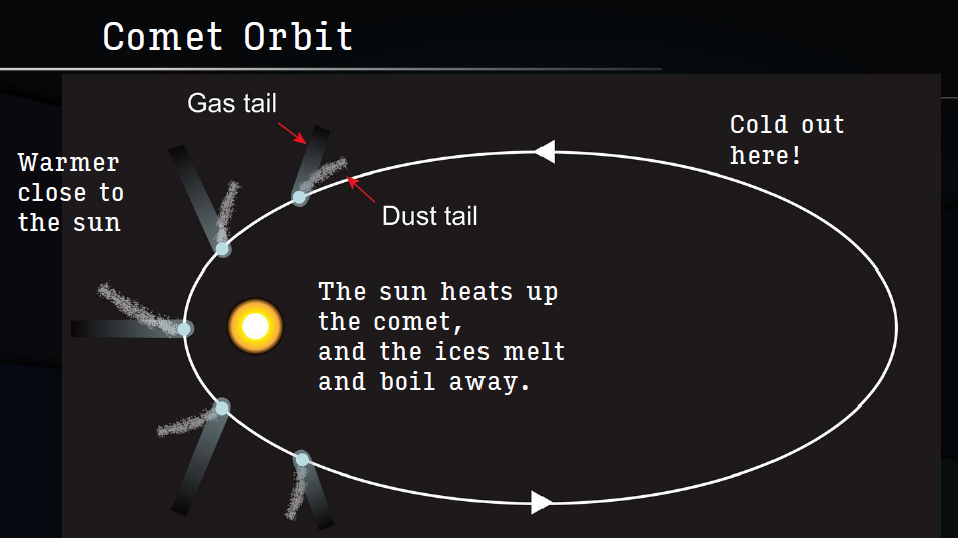Class 17: Small bodies of the solar system: comets, asteroids, and dwarf planets
Summary
Comets: Icy bodies that release gas or dust; they often develop tails when near the Sun.
Asteroids: Rocky objects primarily found in the asteroid belt between Mars and Jupiter; they vary in size and composition.
Dwarf Planets: Celestial bodies that orbit the Sun and are similar to planets but do not clear their orbital path; examples include Pluto and Eris.
Asteroids
Composition: mainly rock and metal
Orbits are elliptical: the time of an orbit (or the period) depends on its semi-major axis
25 million larger asteroids have been identified in our solar system, with a significant number exceeding 1 kilometer in diameter.
600 larger asteroids have been identified to have a diameter of 50km
Jupiter’s affect on the orbit of the asteroids
orbits in exact resonance with Jupiter get displaced
Ceres
is the largest object in the asteroid belt and is classified as a dwarf planet; looks like the moon, or Mercury
Although it’s a dwarf planet, Ceres is massive enough to have achieved hydrostatic equilibrium— the strength of gravity is stronger than the strength of the rock/ice it’s made of— giving it a nearly round shape and distinguishing it from other smaller asteroids.
There is a large identifiable white spot, which is salt that deposits from a cryo-volcano, which is still active after a meteor strike
There’s also a 4km tall mountain called Ahuna Mons
there’s also landslides on the crater wall, taken by the satellite Dawn
This geological activity suggests that Ceres has a complex interior structure, possibly containing a subsurface ocean, which intrigues scientists studying the potential for life beyond Earth.
Ceres’ Interior
It has a rocky core followed by a liquid brine underneath an icy crust— topped off with dark dust on its surface
this explained why Ceres was so geologically active- it’s not just a rock
Vesta
The largest asteroid, around half the size of Ceres
Does not have a spherical shape, so it is not considered a Dwarf planet
Vesta’s Interior
nickle/iron core followed by a silicate mantle and crust, which contribute to its unique geological features and surface composition.
at one point, Vesta was hot enough to have a liquid interior, but its layers formed due to differentiation (making it not homogenous
Eros
Gravity measurements indicate that it’s homogenous
it has cratering, meaning its surface is old
OSIRIS-Rex Mission to Asteroid Bennu
OSIRIS-Rex observed small objects flying off the asteroid
Tracking these particles were used to identify Bennu’s interior- findings suggest that it is low-density, meaning it may be hollow
Kuiper’s Belt
20-200x more massive than the Asteroid Belt
Includes several known dwarf planets, including Pluto
Formed outside the frost line
Pluto and its Moons
Pluto is very distant and quite unique: it has a cratered surface, nitrogen ice plains, and water ice mountains
its orbital period (year) is 248 Earth years
its orbit is inclined, meaning its not in the ecliptic plane
it crosses Neptune’s orbit and is in a 3:2 resonance with Neptune, so they never collide
Charon, Pluto’s moon, is very large for a moon orbiting a dwarf planet like Pluto; this moon has more craters than Pluto and its surface is mainly water ice
Comets
Appear (although rarely) in the night sky
Are visible for days
have tails pointing roughly away from the sun
often come back on a fixed period (decades to millenia)

Comet Tails
Comet tails are formed by the sublimation of ices and the release of gas and dust as the comet gets closer to the sun (causing its composition to boil away from the heat giving it the tail)
has “two” tails— its gas tail and its dust tail, both point roughly away from the sun
gas/plasma tail is pushed directly away from the sun by the solar wind, creating a straight, narrow tail, while the dust tail, composed of larger particles, follows a more curved path that points slightly behind the gas tail due to the comet's trajectory and the influence of solar radiation pressure, as it is accelerated less.
Albedo
refers to the reflectivity of a surface, indicating how much sunlight is reflected back into space versus how much is absorbed. A higher albedo means a surface reflects a greater proportion of sunlight, which can affect the thermal characteristics and visibility of celestial bodies such as comets and asteroids.
some comets are almost perfectly pitch black
The Oort Cloud
A huge spherical cloud of comets outside the Kuiper belt
the comets in the Oort cloud were formed near Jupiter, but were kicked out by gravitational interactions
Instant Review Quiz: What is the main distinction between an asteroid and a comet? Answer: its composition
Meteors & Meteorites
every night, millions of objects strike the Earth— most are as small as a grain of sand and burn up in the atmosphere
sometimes, they do hit the earth, and are then called meteorites which can be large enough to be destructive
Cretaceous-Paleogene Extinction Event
an asteroid or comet— around 30km across— struck the Earth, causing the extinction of most dinosaurs
